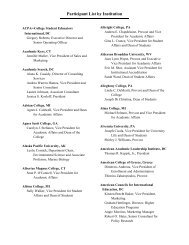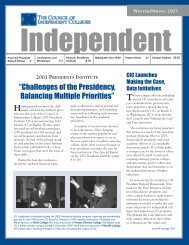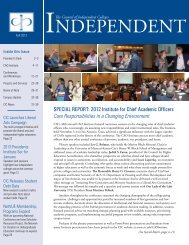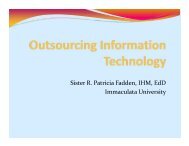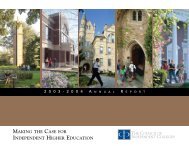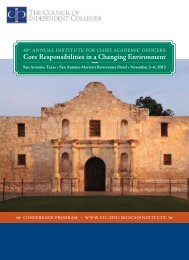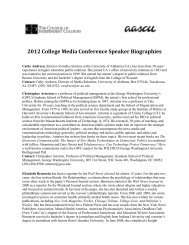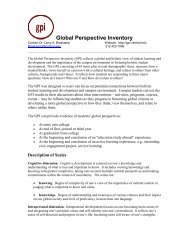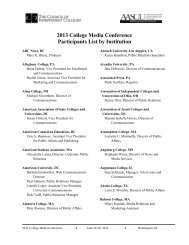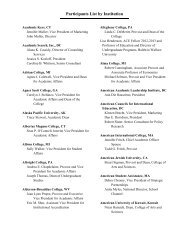Summer 2009 - The Council of Independent Colleges
Summer 2009 - The Council of Independent Colleges
Summer 2009 - The Council of Independent Colleges
You also want an ePaper? Increase the reach of your titles
YUMPU automatically turns print PDFs into web optimized ePapers that Google loves.
PRESIDENT’S DESK<br />
that institutional autonomy has allowed enormous diversity to<br />
develop among undergraduate institutions, in their curricula<br />
and philosophies <strong>of</strong> education, and in encouraging a culture <strong>of</strong><br />
innovation and entrepreneurial spirit that has produced many<br />
good results. Moreover, the stimulation <strong>of</strong> competition among<br />
colleges and universities has kept U.S. higher education from<br />
becoming bureaucratic, stale, and politicized.<br />
To be sure, in this market environment, a few colleges and<br />
universities <strong>of</strong>fer programs that are popular but not rigorous.<br />
Even so, there is little reason to worry; the market itself adjusts<br />
for low-quality institutions by allowing students to enroll<br />
elsewhere. <strong>The</strong> survival <strong>of</strong> a small number <strong>of</strong> low-quality<br />
programs is a trivial price to pay for the widespread ferment<br />
in program development that characterizes most colleges and<br />
universities and the breakthroughs that transform teaching or<br />
advance scientific or scholarly knowledge.<br />
Some ask why we are so skeptical about the growth <strong>of</strong><br />
for-pr<strong>of</strong>it higher education, if we are so quick to defend the<br />
competitive environment and the prerogative <strong>of</strong> each institution<br />
to act autonomously. <strong>The</strong> answer is that the pr<strong>of</strong>it motive has,<br />
in almost every instance that we’ve seen so far, caused operating<br />
costs at for-pr<strong>of</strong>it colleges to be squeezed too tightly, so that<br />
faculty members are denied any space for imagination in what<br />
they teach, student support services are reduced to skeletal<br />
levels, and pr<strong>of</strong>its are drawn out <strong>of</strong> the enterprise instead <strong>of</strong><br />
being used to enrich it for the benefit <strong>of</strong> students or to pay for<br />
long-term improvements. In principle, a for-pr<strong>of</strong>it college could<br />
demonstrate deep commitment to student learning, but the<br />
financial incentives seem so far to have prevented the for-pr<strong>of</strong>it<br />
colleges from doing it.<br />
As metrics for gauging institutional performance have<br />
improved, accreditors now ask colleges for more data, and most<br />
colleges and universities now have the capacity to collect and<br />
analyze data for their own internal benchmarking purposes.<br />
When CIC began its Key Indicators Tool in 2004, some college<br />
presidents were nervous that the data, once collected, could fall<br />
into the hands <strong>of</strong> accreditors who would use the information<br />
against the institution. Now many colleges find that the<br />
information in the Key Indicators Tool and companion Financial<br />
Indicators Tool <strong>of</strong>fers an easy way to comply with accreditors’<br />
requests for measures <strong>of</strong> institutional performance.<br />
Another force for greater standardization, now on the<br />
horizon, will pose a new challenge to the peculiarly American<br />
balance between a concern for learning outcomes and the<br />
protection <strong>of</strong> institutional autonomy. This challenge derives from<br />
the national effort to increase the number <strong>of</strong> well trained college<br />
graduates who enter the workforce and add to our national<br />
economic strength and competitiveness on the world stage. In<br />
Europe, the “Bologna Process” has led to new agreements among<br />
nations to allow easier equivalency <strong>of</strong> credits and degrees and<br />
mobility <strong>of</strong> students among universities in different countries.<br />
Interest in extending this approach to the U.S. is increasing<br />
because, if it is difficult to transfer credits earned in, say, India<br />
or Zambia to an American college or university, the Indian or<br />
Zambian student will enroll in a European university, where<br />
transferring is easier.<br />
We want American universities and colleges to remain<br />
attractive to foreign students, but we cannot achieve this<br />
goal by imposing a simple federal template on all college and<br />
university degree programs or we will risk the stultifying effects<br />
<strong>of</strong> a centralized, government-run system <strong>of</strong> higher education.<br />
To prevent a federal mandate, we need to demonstrate that<br />
the voluntary approaches that have taken us some distance<br />
in just a few years can take us much further. <strong>The</strong>n we will<br />
need to persuade those who prefer legal remedies that these<br />
would constrain innovation, discourage diversity among<br />
institutions, and lead to additional expense for compliance and<br />
enforcement—all without assuring better information or higher<br />
educational quality than the voluntary approaches currently do.<br />
Accountability aside, it’s our focus on improvement <strong>of</strong> teaching<br />
and learning, not mere compliance, that will assure that even the<br />
best colleges and universities become even better.<br />
Here’s our dilemma. When Secretary Spellings was railing<br />
against colleges and universities and the Republicans, despite<br />
all expectations, were asserting the need for more federal<br />
involvement in our institutions, it was easy to be firmly opposed.<br />
Secretary Duncan, on the other hand, always sounds supportive<br />
and collegial. Yet he and the Democratic Congress apparently<br />
want even deeper, direct regulation <strong>of</strong> higher education. Dare<br />
we trust today’s more congenial government <strong>of</strong>ficials to help us<br />
find a non-governmental path to quality assurance, or are the<br />
principles <strong>of</strong> institutional autonomy, privacy, and diversity <strong>of</strong><br />
institutions important to protect even when there appears to be<br />
little immediate threat And how can we persuade the state and<br />
federal governments that the leading example set by “private”<br />
higher education is serving the “public” interest extremely well<br />
<strong>Independent</strong> | <strong>Summer</strong> <strong>2009</strong> 3



